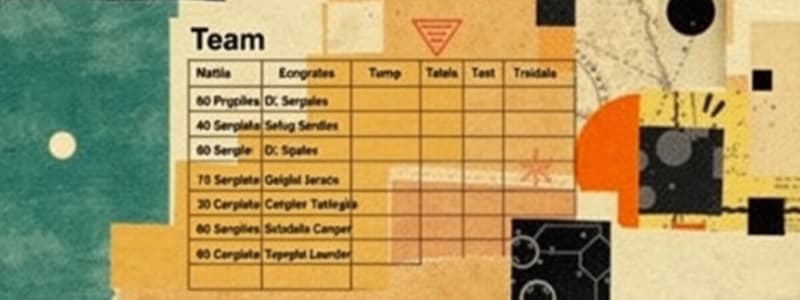Podcast
Questions and Answers
What is the typical duration of an iteration, as advised by SAFe?
What is the typical duration of an iteration, as advised by SAFe?
- Four weeks
- Three weeks
- Two weeks (correct)
- One month
What is the primary goal of each iteration?
What is the primary goal of each iteration?
- To finalize the PI objectives
- To complete all planned tasks, regardless of value
- To deliver new value to the Customer (correct)
- To hold daily team sync meetings
Which of the following is a key activity that occurs within each iteration?
Which of the following is a key activity that occurs within each iteration?
- Revisiting the company's mission statement
- Annual performance reviews
- Defining, building, integrating, and testing Stories (correct)
- Budget planning for the next fiscal year
What should be avoided once an iteration has begun?
What should be avoided once an iteration has begun?
What is a system demo?
What is a system demo?
What are PI Objectives?
What are PI Objectives?
What are iteration retrospectives?
What are iteration retrospectives?
Who owns and prioritizes the Team Backlog?
Who owns and prioritizes the Team Backlog?
What does the Team Backlog primarily represent?
What does the Team Backlog primarily represent?
What is a key characteristic of work included in the Team Backlog?
What is a key characteristic of work included in the Team Backlog?
What is a significant benefit of implementing stories in vertical slices?
What is a significant benefit of implementing stories in vertical slices?
Implementing stories in vertical slices facilitates what?
Implementing stories in vertical slices facilitates what?
What does implementing stories in vertical slices allow for?
What does implementing stories in vertical slices allow for?
What is the effect of implementing stories in vertical slices?
What is the effect of implementing stories in vertical slices?
Flashcards
Team Backlog
Team Backlog
A list of all possible work items for the team.
Who owns the Team Backlog?
Who owns the Team Backlog?
The Agile Team creates it; the Product Owner prioritizes and owns it.
Team Backlog: Opportunities, not...
Team Backlog: Opportunities, not...
The Team Backlog represents possibilities, rather than firm promises.
Vertical slices
Vertical slices
Signup and view all the flashcards
Benefits of vertical slices
Benefits of vertical slices
Signup and view all the flashcards
NFRs
NFRs
Signup and view all the flashcards
Incremental Development
Incremental Development
Signup and view all the flashcards
What are Iterations?
What are Iterations?
Signup and view all the flashcards
Iteration Duration
Iteration Duration
Signup and view all the flashcards
Iteration Goal
Iteration Goal
Signup and view all the flashcards
Iteration scope changes
Iteration scope changes
Signup and view all the flashcards
Iteration Development Flow
Iteration Development Flow
Signup and view all the flashcards
What are PI Objectives?
What are PI Objectives?
Signup and view all the flashcards
What are system demos?
What are system demos?
Signup and view all the flashcards
Study Notes
- The team backlog organizes the team's work.
- A piece of work might get done if it is in the backlog.
- Estimates may be assigned to work sizes but don't imply committed delivery.
- The Agile Team creates The Team Backlog.
- The Product Owner owns and prioritizes the backlog.
- Backlogs represent opportunities, not commitments.
Foundation for Incremental Development
- Implementing stories in vertical slices is key to incremental development.
- This enables a short feedback cycle.
- It allows refinement of understanding of functionality.
- It facilitates more frequent integration of working systems. -Vertical slices: -Slice 1: Initial story functionality -Slice 2: Further functionality within the scope of the story -Slice 3: Remaining story functionality
Agile for Team: Scrum
- The team backlog comes from PI planning and local team context.
- Iterations are typically two weeks.
Iteration Basics
- Iterations definition: -Iterations are a single development cycle where each Agile Team defines, builds, integrates, and tests the stories from their Iteration Backlog
- Iteration duration: -Each iteration is the same length, running back-to-back and SAFe advises two-week iterations
- Iteration Goal: -To deliver new value to the customer at the end of each iteration
- Avoid adding scope once the iteration has begun.
- Plan, Do, Check, Adjust (PDCA) -Iteration Planning ->Iteration Execution ->Iteration Review ->Iteration Retrospective
Studying That Suits You
Use AI to generate personalized quizzes and flashcards to suit your learning preferences.
Description
Understanding the team backlog in Agile, its creation, and prioritization. Learn about incremental development through vertical slices and the role of iterations in Agile Scrum.




